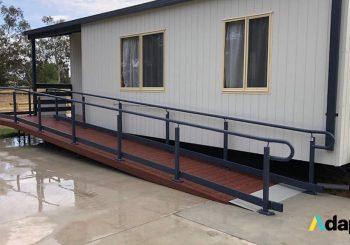A person with a disability has a right to have access to places used by the public.
You and The Disability Discrimination Act
A huge part of what we do at Adapta is ensuring that people from all walks of life are able to safely and conveniently access their home, hospitals, schools and other public facilities. Our passion for providing equal access extends to people with disabilities and this is where we work alongside The Disability Discrimination Act.
The Disability Discrimination Act (DDA) makes it against the law for public places to be inaccessible to people with a disability. All of Adapta’s products are built with this in mind and we aim to make it as easy as possible for businesses, individuals and organisations to install access solutions that are compliant.
Our pre-fabricated kits are easy to customise to suit each unique space and even easier to install. If your building is lacking appropriate access solutions that allow people with disabilities to easily use your facilities, have a chat with our friendly team about the options we can provide to ensure you’re meeting the standards set by the DDA.
To better understand the DDA, we’ve answered a few of the most common questions you may have.
What are some examples of places used by the public that need to be DDA compliant?
- Public footpaths and walkways
- Educational institutions
- Shops and department stores
- Banks, credit unions, building societies
- Parks, public swimming pools, public toilets, and pedestrian malls
- Cafes, restaurants, pubs
- Theatres and other places of entertainment
- Lawyers’ offices and legal services
- Sporting venues
- Social and sporting clubs
- Government offices, services and libraries
- Public transport including trains, buses, ferries, boats, ships and planes
- Hospitals, dentists’ and doctors’ surgeries
- Hairdressers and beauty salons
What are my responsibilities?
Every area and facility open to the public should be open and available to people with a disability. They should expect to enter and make use of places used by the public if people without a disability are able to do so. If your building or facility is not easily accessible by people with disabilities, you’ll need to assess how you can incorporate an access solution such as ramp, rails or a lift in order to provide access.
What are some examples of DDA compliance?
- Places used by the public should be accessible at the entrance and inside.
- Facilities in these places should also be accessible (such as with wheelchair-accessible toilets, lift buttons within reach, tactile and audible lift signals for people with vision impairments).
- Rather than being confined to a segregated space or the worst seats, all areas within places used by the public should be accessible to people with a disability.
- Information available to users of the premises should be accessible.
What if providing access is too difficult?
The DDA does not require the provision of access to be made if this will cause major difficulties or excessive costs to a person or organisation. This is called “unjustifiable hardship”.
But before deciding that providing access is unjustified, you need to:
- thoroughly consider how access might be provided,
- discuss this directly with the person involved, and
- consult relevant sources of advice.
If adjustments cause hardship it is up to you to show that they are unjustified.
- Contact the Adapta team to find out more about the Disability Discrimination Act and how it affects you.



